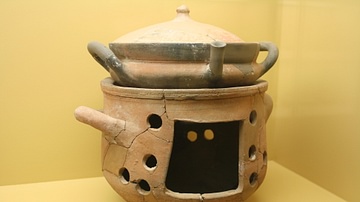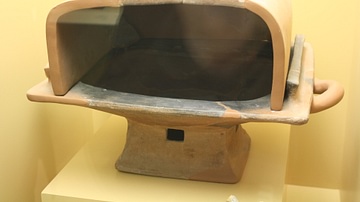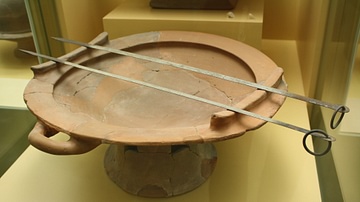Search Images
Browse Content (p. 1550)

Image
Cycladic Kernos
A kernos from the Cyclades, used to give multiple votive offerings. Phylakopi, Melos, 2300-2200 BCE. (National Archaeological Museum, Athens)

Image
Mycenaean Marine Style Amphora
A Mycenaean three-handled amphora imitating the Minoan Marine Style, 15th century BCE. From a cemetery in Argive Prosymna. (National Archaeological Museum, Athens)

Image
Mycenaean Gold Cup
A gold Mycenaean cup with handles ending in dog's heads. 15th century BCE from Grave circle A, Mycenae. (National Archaeological Museum, Athens)

Image
Bronze Weights
Standardized Greek bronze weights, c. 500 BCE. (Agora Museum, Athens)

Image
Child's Commode
A child's commode, terracotta, 6th century BCE.
Agora Museum, Athens.

Image
Spouted Casserole Dish
A spouted casserole dish (lopas) including lid and resting upon a brazier. Terracotta, 6th-4th centuries BCE. (Agora Museum, Athens)

Image
Cooking Brazier (Eschara)
A shallow rectangular cooking brazier (eschara) in terracotta, including cover. 6th-4th century BCE. (Agora Museum, Athens)

Image
Cooking Hearth With Cover
A shallow terracotta cooking hearth with bell-shaped cover. 6th-4th centuries BCE. (Agora Museum, Athens)

Image
Eschara (Greek Brazier)
A shallow brazier (eschara) in terracotta with metal spits. 6th-4th century BCE. (Agora Museum, Athens)

Image
Greek Tragedy Mask
A terracotta tragic theatre mask, 200-250 BCE. (Agora Museum, Athens)